The children’s edutainment industry is booming, offering an array of enrichment programs that blend education with entertainment. As traditional children’s activities like sports are seeing a decline in participation, parents are increasingly seeking out alternatives that engage their children in fun, creative, and educational experiences. In this blog, we’ll explore the size and scope of the children’s edutainment sector, why it’s growing, and how businesses like The Fashion Class are playing a crucial role in shaping this market.
What Is Children’s Edutainment?
Edutainment combines education and entertainment, offering children the chance to learn while having fun. This sector includes:
- Enrichment programs (such as music, art, STEM, and fashion design classes)
- Interactive play centers
- Workshops and camps
- Educational toys and games
The focus is on providing kids with experiences that stimulate their creativity, critical thinking, and hands-on skills, while making the learning process engaging and enjoyable.
The Size and Growth of the Children’s Edutainment Market
The global edutainment market has been expanding rapidly. According to recent reports, the global edutainment industry was valued at over $9 billion in 2021 and is projected to grow at a CAGR of 17.2% between 2022 and 2030 . The children’s sector within this industry is a significant driver of that growth, as parents continue to prioritize activities that nurture their children’s development in creative and meaningful ways.
Why Is Edutainment Growing?
There are several factors contributing to the rise of children’s edutainment programs:
Decline in Traditional Sports Participation
Sports have long been a go-to for children’s extracurricular activities, but participation is on the decline. Studies show that since 2008, children’s participation in team sports has dropped by almost 40% . With rising concerns about injuries, safety, and over-scheduling, many parents are opting for enrichment programs that are less physically demanding but still offer valuable skill-building.
Demand for Creative and Educational Alternatives
Modern parents are increasingly focused on providing their children with opportunities that go beyond traditional academics or sports. Programs that allow children to express creativity, build problem-solving skills, and explore new areas of interest are gaining popularity. STEM, art, and fashion design classes offer students a chance to learn real-world skills in an enjoyable and engaging environment.
Changing Lifestyle and Work Trends
Many parents are balancing busy careers and are looking for enrichment programs that not only educate but also entertain and occupy their children during after-school hours or weekends. The rise of work-from-home arrangements has also driven parents to seek out structured activities for their children that keep them engaged and learning.
The Fashion Class: A Key Player in Children’s Edutainment
As an example of a thriving edutainment business, The Fashion Class offers unique programs for kids, teens, and even adults. Their sewing and fashion design classes allow children to develop creative and practical skills while having fun.
With programs that include beginner sewing, fashion camps, and design classes, The Fashion Class is not just about teaching kids to sew—it’s about empowering them to express their creativity, solve problems, and build confidence in a supportive environment. The Fashion Class also emphasizes teaching students life skills like patience, focus, and precision, all while offering an engaging, hands-on experience.
This type of interactive learning is precisely what today’s parents are looking for, especially as the focus shifts away from traditional sports and moves towards creativity-driven activities that align with children’s passions and long-term skill development.
Edutainment Franchise Opportunities
Entrepreneurs looking to enter the growing children’s edutainment sector have a variety of opportunities. One of the best ways to enter this market is through a franchise model, like that offered by The Fashion Class.
Owning a The Fashion Class franchise allows entrepreneurs to benefit from an established brand, a proven curriculum, and a support system that helps franchisees grow their business. In addition to offering sewing and fashion design classes, franchise owners can provide fun birthday parties, fashion shows, and camps—attracting a wide range of students and creating multiple streams of revenue.
Decline in Children’s Sports Activities
As noted earlier, sports activities for kids are seeing a significant decline. According to a report by the Aspen Institute, participation in youth sports dropped from 45% in 2008 to 38% by 2020 . Several factors contribute to this trend:
- Injury Concerns: Increased awareness of injuries like concussions in contact sports has led many parents to steer their children away from sports.
- Cost of Participation: Many organized sports programs have become costly, making them inaccessible to some families.
- Over-structured Schedules: Parents are wary of over-scheduling their children, opting for more flexible, creative outlets like edutainment programs.
This decline is creating a market shift, with parents seeking alternative activities that offer both learning and enjoyment, fueling the growth of the edutainment industry.
The Future of Children’s Edutainment
The children’s edutainment market shows no signs of slowing down. As more parents look for enrichment programs that blend fun and learning, businesses that offer creativity-based activities like fashion design, coding, art, and music will continue to thrive.
With parents increasingly prioritizing educational activities that teach life skills, the shift away from traditional sports will likely continue. Businesses like The Fashion Class are well-positioned to capitalize on this trend, offering a blend of fun, learning, and skill-building that appeals to both kids and their parents.
Conclusion
The children’s edutainment industry is a fast-growing sector that offers an exciting array of opportunities for both educators and entrepreneurs. With the decline in traditional youth sports and the rise in demand for creative, engaging activities, enrichment programs like those offered by The Fashion Class are becoming more popular than ever.
By blending education with entertainment, The Fashion Class provides kids with valuable life skills, fosters creativity, and builds confidence. Whether you’re a parent looking for the perfect activity for your child or an entrepreneur seeking a business opportunity in the expanding edutainment space, the future of this industry looks bright.












